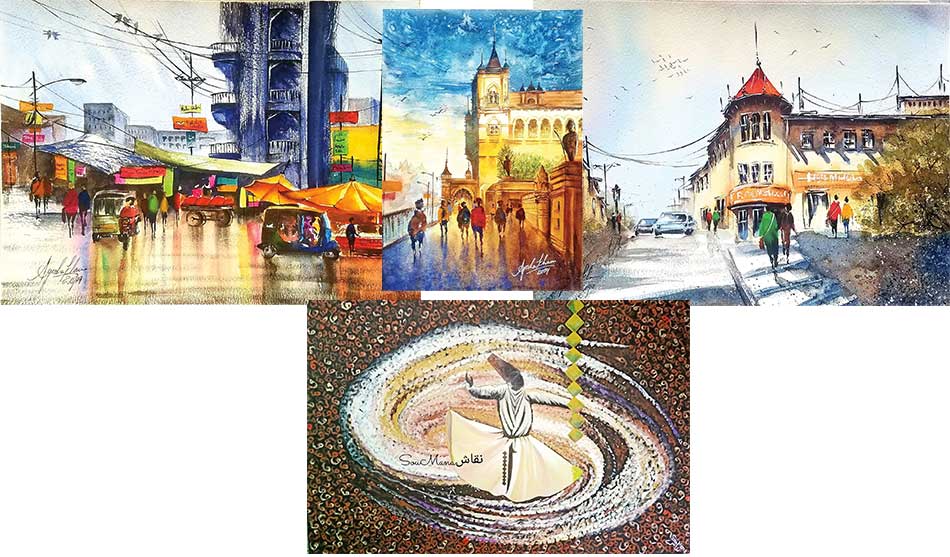ZULFIQAR ALI ZULFI’S HUES OF DUSK
- 29 Oct - 04 Nov, 2022
Nuqta-e-Nazar – a depiction of pure artistry was displayed by a group of four women who exhibited different perspectives to look at the larger picture of life. Four, essentially disparate types of works presented at the exhibition were texture, landscape and traditional art with a splash of bright colours conveying the message of the artists through their art form at Meubels Art Gallery in Clifton. Yes, I was a bit hesitant at first about dropping by, since I never had the exposure to an art exhibition of this sort before. But I believe art lures people in. The gallery itself is a very fancy eye-catching site as you enter. My visit took me to meet Tayyba Asif, Sumana Naqash, Ayesha Khan and Kaneez Fatima, the four artists who illustrated their perceptions on the canvases.

Tayyaba Asif, the artist and curator of the exhibition showcased four of her unique pieces; “It represents my thoughts, my imagination and little things that occur in my mind,” said Tayyaba, when I asked her about the representation of her artwork. She confided that painting is a therapy for her and she thoroughly enjoys all the feeling associated with it. I really was interested in the techniques she used for creating her art pieces, and she walked me through her creative process and artistic methods employed, which included oil paints, ceramics and embossed patterns for her collection. “I really don’t like to limit myself to anything, and I try to use everything I can,” reiterated Asif. According to her, Nuqta-e-Nazar holds a very strong emotional value for her, since it represents her frame of mind. The beauty of being a woman and the troubled patterns were the main focus of her paintings for this particular exhibition. She was happy about the fact that a lot of appreciation came her way for the displayed work with the overall collection garnering a great response.
The one painting which caught my eye was of a Dancing Dervish named The One I Love is Everywhere, quintessentially inspired by Rumi, with a blend of beautiful contrasting colours spun from acrylics. Upon searching for the creator’s name I got to know, it was artist Sumana’s creation. I later discovered other paintings had the same theme of free-spirited dancing. The artist relayed that most of her artwork focuses on Sufism and art stemming from religious references. I wanted to know the inspiration behind her collection to which she told that Dervishes intrigues her to no end and that she is really fond of painting Turk Dervishes which reflected through her paintings as well. “My Nuqta-e-Nazar collection had two topics on focus, one was Sufi and the other was a much modern version of the same. Sufi paintings describe the love of Allah, while the modern theme is describing happiness. I have used vibrant colours in modern art,” quoted Soumana. “Mostly I use brush, knife and my fingers to give different textures and I love to work with acrylic paints,” she shared.
An entire set of collection were dedicated to visually-stunning landscapes which caught the roving eye. Breathtakingly-beautiful sceneries and charms of old cityscapes were stained aesthetically on the canvas by artist Ayesha Khan, whose muse was nature. Khan divulged, that she loves playing with colours which made painting her passion. She narrated that her artwork which she presented at the gallery was all about showing the vibrant colours of buildings and the happening street life. She worked with water colours very delicately to delineate intricate designs on the canvas.
Next up, I saw very precisely depicted, colour-stained patterns on the canvas which were the creations from Kaneez Fatima. Upon inquiring what her artwork represents she said, “Most of my artwork represents balance and harmony of the universe through geometric patterns. The beautiful geometric patterns in traditional arts.” She shared that the paintings which she selected for the exhibition shows how the traditions flow in the universe in a form of four, six and 10 folds showing Islamic traditional geometry. As I asked about how she created these pieces, she said that they were basically gauche paints on paper. “As it is connected to each mankind and their traditions, it immensely effects on hearts of viewers and a prompt connection can be developed,” she concluded. •
COMMENTS